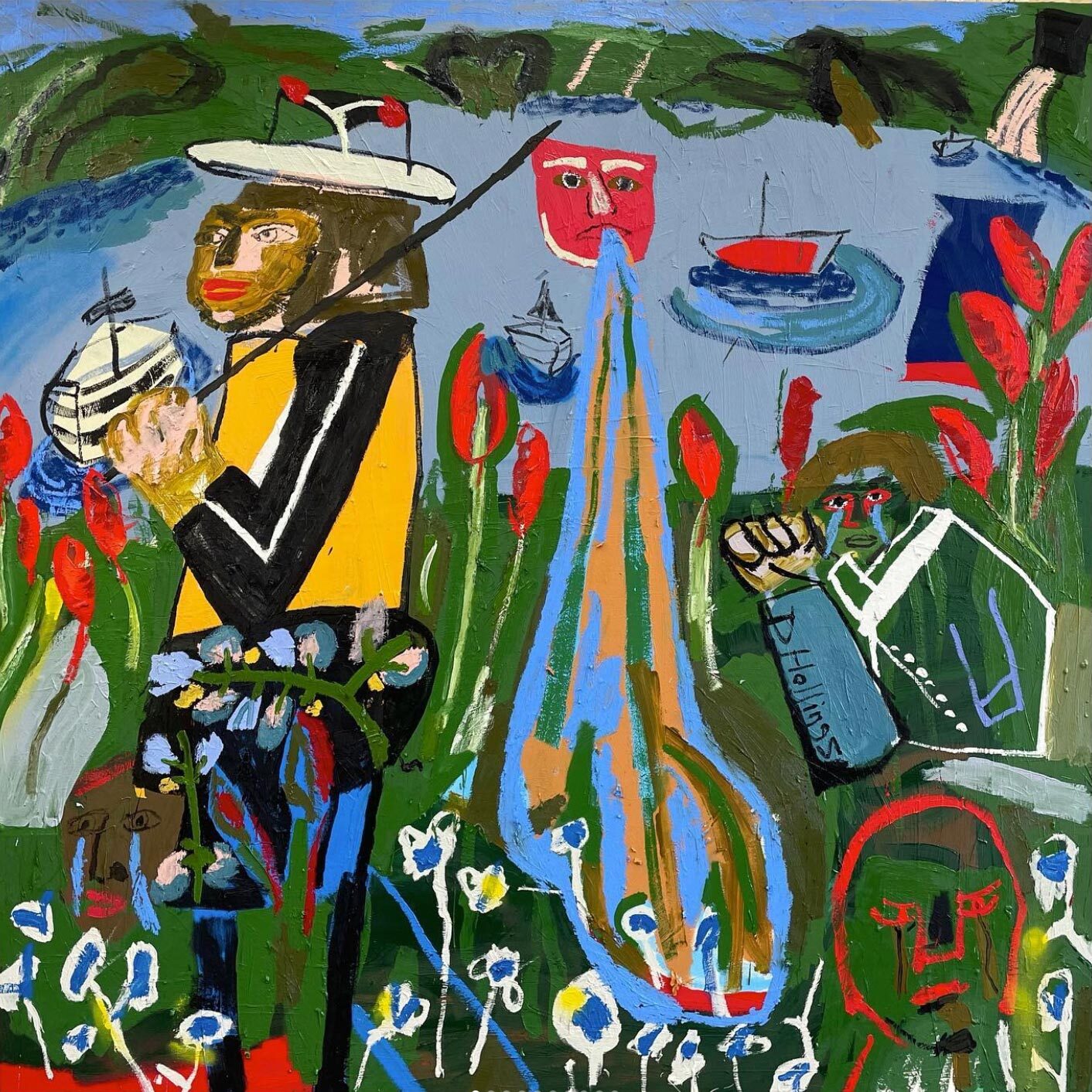
I recently had a chat with Dan Hollings on FaceTime. This lockdown studio visit, although incomparable to actually being there with paint fumes in my nostrils, seemed quite fitting. It was through the oblong screen of my phone, a few years ago, where I first got to know his work. As we talked, I caught glimpses of new paintings over Dan’s shoulder, oil splattered sheets, piles of magazines, a St Piran’s flag hanging from the ceiling. Dan’s studio is in Redruth, and he moved here after he graduated from Falmouth School of Art in 2018. This transition from an outward looking maritime town, to one of the most landlocked places in Cornwall has been an instrumental shift, significantly informing his latest work. The canvasses made in Falmouth sometimes referenced the sea, as one might expect, but curiously they always looked inwards, towards the land. This sense of perspective has been concentrated further by Redruth during lockdown.
Dan isn’t interested in Cornwall by and of itself, but rather the people that make it, his paintings are about the minutiae of life, a stroll around town is much more fascinating to him than attempting to grasp the unfathomable sea. As he tells me, he is naturally inquisitive, or in his own words, he’s a nosy bastard, but it’s through people watching and chance encounters that he finds the greatest inspiration. He refers to this as allowing things to flutter in, a simple yet poetic phrase, describing his method of gathering material. Moments of happenstance, snippets of overheard conversations, birds puncturing the sky, are all things that might be recalled through paint several months later. You would think that our recently enforced isolation would be detrimental to this, but instead, lockdown has afforded Dan an unexpected freedom, the perfect conditions for the happy accidents that so inspire him. With social distancing in place, there’s no longer a sense of being watched over, or the need to perform as an artist. With only himself to please, he’s no longer precious, and the paint is allowed to take over. This new sense of freedom, as we will learn, has also led to an unabashed engagement with the principal genres of self-portraiture and still-life, something which came as an unexpected surprise.
That pile of magazines I noticed is in fact another catalyst for his work - images are ripped out and stuck to the wall, visual fragments building up until they spark something new. This is a method much used by artists, take the example of Francis Bacon - but for Dan the written word also holds an equal significance. He works with a cut-up method, much like writer William Burroughs; his experiences, the phrases he hears, glimpses of life, are first committed to paper in words. This is often though poetry and accompanied by a quick sketch, and fragments of these will later inform a painting’s title, and in-turn the content.
This sense of fragmentation is also linked to Dan’s geographical displacement. Born in Devon, he grew-up in Wales, yet has arguably become a Cornish painter. There is a constant battle with identity, of never quite fitting in, as he tells me, I don’t know where I belong. His paintings explore this in an attempt to find his place, as one of his title’s states: He’s not Cornish, he’s a fake Welsh. Dan joked that in Cornwall it takes twelve years to become a local, a goal that’s obviously never far from his mind. This concern in grappling with Cornishness is also reflected in the artists who inspire him. Danny Fox, St Ives born now based in Los Angeles, Samuel Bassett and Arthur Lanyon, contemporary painters with deep Cornish roots, and Denzil Forrester, a relatively recent incomer to the county. Although he also speaks of an interest in artists such as Peter Laynon or Barbara Hepworth, he works against the idea that Cornish art stopped in the last century and within the bounds of St Ives. As isolated as he may currently feel, it is a sense of a being within a growing and thriving artistic community that is of such comfort. The most recent paintings, however, seem to present a brave face. They are in many respects Dan in conversation himself, something acutely evident in his self-portraits. The facial expressions here are stoic, but this is because a smile, or a frown are too easily read. Even when we see streams of tears, we can’t be sure if they are from a place of sadness or happiness – Big boys don’t cry. Instead, Dan asks the viewer to unpick the multi-layered symbols that are scattered throughout his paintings, an excavation in parity with his gathering of material and inspiration. These symbols are varying, but some are reoccurring; the already mentioned flag of St Piran, moorland, gorse, thistles, magpies and heraldic lions - all of which are historically tied to emotion, fortune or belonging.
Dan is among a handful of painters who speak truly of Cornwall as it is now. His paintings are full of references to this - from street-style and slang, or hot afternoons spent down Gylly beach with friends. This is the power of his works, they are not attempting to deal with the mystical or otherworldly, they are instead about real, grounded and relatable experience. Whether that’s a dropped Cornetto, watching day turn into night, sitting topless in the garden, trousers beginning to fray, or listening to the birds at Pendennis Point. These are all things that have fluttered in, become committed to canvas, a unique pace of life and an uncommon people captured in his paint. To quote John Cooper Clarke, Dan’s favourite poet: where the action isn’t, that’s where it is.